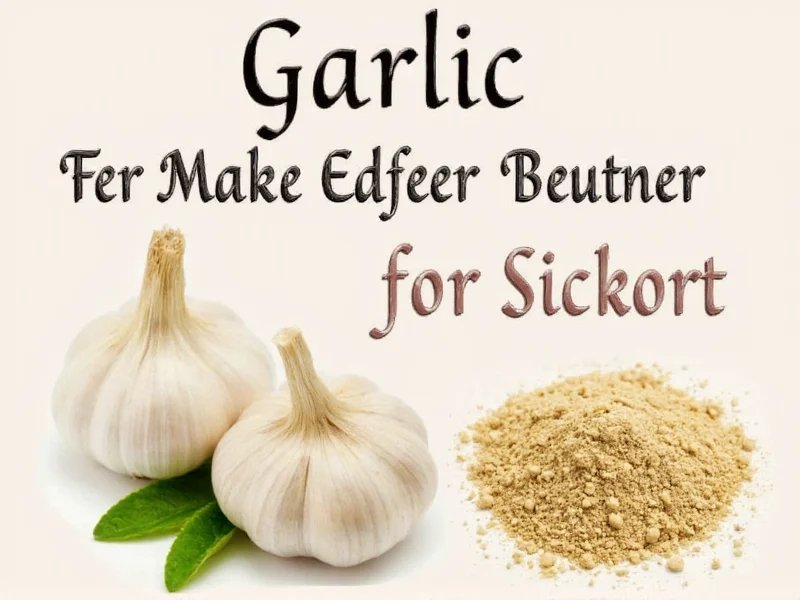Running out of garlic powder mid-recipe doesn't have to ruin your cooking plans. This comprehensive guide provides practical garlic powder alternatives with precise conversion ratios and usage tips that maintain your dish's intended flavor profile. Understanding these substitutions ensures your culinary creations remain delicious even when your spice cabinet falls short.
Top Garlic Powder Substitutes Explained
Garlic powder offers concentrated garlic flavor with convenient shelf stability, but several excellent alternatives exist when you need a quick replacement. Each substitute brings unique characteristics that work better in specific cooking scenarios.
Fresh Garlic
Fresh garlic provides the most authentic garlic flavor but requires conversion since its potency differs from dried powder. Use one medium garlic clove (finely minced) for every 1/8 teaspoon of garlic powder called for in your recipe. For stronger garlic presence, increase to 1 clove per 1/4 teaspoon of powder. Fresh garlic works exceptionally well in sauces, stir-fries, and roasted dishes where its moisture content won't affect texture.
Garlic Salt
When using garlic salt as a garlic powder substitute, remember it contains approximately 3 parts salt to 1 part garlic. Substitute 3/4 teaspoon of garlic salt for every 1 teaspoon of garlic powder, then reduce additional salt in your recipe by 1/4 teaspoon per teaspoon substituted. This alternative works well in rubs, marinades, and savory baked goods where the extra salt won't compromise results.
Garlic Granules
Garlic granules (sometimes labeled garlic chips) offer similar flavor to powder but with coarser texture. Use a 1:1 ratio when substituting granules for powder, though they may not dissolve as completely in liquids. These work particularly well in slow-cooked dishes, meat rubs, and dry spice blends where texture matters less.
Onion Powder
When garlic isn't available at all, onion powder provides the closest allium family flavor profile. Use half the amount of onion powder compared to garlic powder since it has stronger flavor intensity. This substitute works best in hearty dishes like stews, chili, and meatloaf where the flavor difference won't dominate.
| Substitute | Conversion Ratio | Best For | Limitations |
|---|---|---|---|
| Fresh Garlic | 1 clove = 1/8 tsp powder | Sauces, stir-fries, roasted dishes | Moisture content affects texture |
| Garlic Salt | 3/4 tsp = 1 tsp powder | Rubs, marinades, savory baked goods | Requires sodium adjustment |
| Garlic Granules | 1:1 ratio | Slow-cooked dishes, meat rubs | Coarser texture, slower dissolution |
| Onion Powder | 1/2 amount of powder | Stews, chili, meatloaf | Different flavor profile |
| Garlic Paste | 1/2 tsp = 1 tsp powder | Asian cuisine, dressings | Stronger flavor, oil separation |
Special Considerations for Garlic Substitutions
When substituting garlic powder, consider your recipe's specific requirements. For low-sodium diets, avoid garlic salt and opt for fresh garlic or granules instead. In baking applications like garlic bread or savory muffins, garlic powder's fine texture provides more even distribution than fresh garlic.
For recipes requiring long cooking times like soups and stews, fresh garlic added early develops milder flavor while garlic powder maintains consistent intensity throughout cooking. In quick-cooking dishes like stir-fries, garlic powder provides immediate flavor without risk of burning that fresh garlic faces.
When Substitutes Won't Work Well
Some recipes specifically require garlic powder's unique properties. In dry spice rubs for immediate cooking, fresh garlic's moisture can create steam instead of searing. In commercial food production, garlic powder's consistent particle size ensures uniform flavor distribution that substitutes can't match. For precise flavor control in professional cooking applications, nothing replicates garlic powder exactly.
Practical Tips for Successful Substitution
Always taste as you go when substituting garlic powder, especially with fresh alternatives. For baked goods, mix fresh garlic with a small amount of recipe liquid first to distribute evenly. When using garlic salt, remember that different brands have varying salt-to-garlic ratios, so adjust accordingly. For the most authentic flavor in Italian dishes, fresh garlic works best, while garlic powder often performs better in American-style barbecue rubs.
Creating Your Own Garlic Powder Substitute
If you have time, making your own garlic powder substitute provides superior flavor control. Dehydrate fresh minced garlic at 140°F for 6-8 hours until completely dry, then grind to powder consistency. This homemade version lacks the commercial processing that sometimes affects flavor, giving you a fresher-tasting alternative with no additives. Store in an airtight container for up to six months.











 浙公网安备
33010002000092号
浙公网安备
33010002000092号 浙B2-20120091-4
浙B2-20120091-4